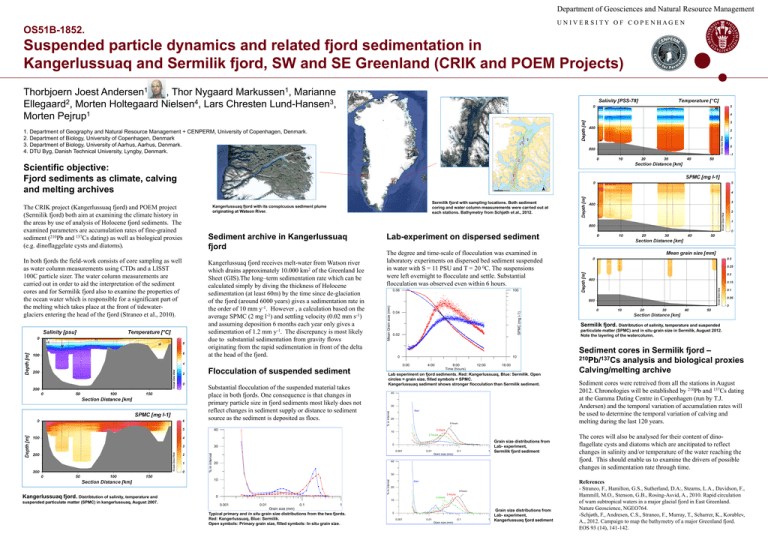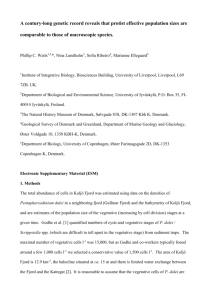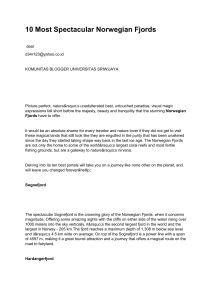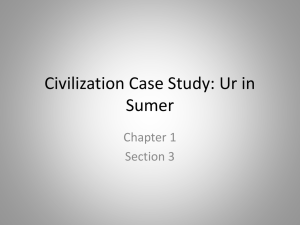View ePoster - 2015 AGU Fall Meeting
advertisement

Department of Geosciences and Natural Resource Management UNIVERSITY OF COPENHAGEN OS51B-1852. Suspended particle dynamics and related fjord sedimentation in Kangerlussuaq and Sermilik fjord, SW and SE Greenland (CRIK and POEM Projects) Thorbjoern Joest Andersen1 , Thor Nygaard Markussen1, Marianne Ellegaard2, Morten Holtegaard Nielsen4, Lars Chresten Lund-Hansen3, 1 Morten Pejrup 1. Department of Geography and Natural Resource Management + CENPERM, University of Copenhagen, Denmark. 2. Department of Biology, University of Copenhagen, Denmark 3. Department of Biology, University of Aarhus, Aarhus, Denmark. 4. DTU Byg, Danish Technical University, Lyngby, Denmark. Scientific objective: Fjord sediments as climate, calving and melting archives Sediment archive in Kangerlussuaq fjord Kangerlussuaq fjord receives melt-water from Watson river which drains approximately 10.000 km2 of the Greenland Ice Sheet (GIS).The long–term sedimentation rate which can be calculated simply by diving the thickness of Holocene sedimentation (at least 60m) by the time since de-glaciation of the fjord (around 6000 years) gives a sedimentation rate in the order of 10 mm y-1. However , a calculation based on the average SPMC (2 mg l-1) and settling velocity (0.02 mm s-1) and assuming deposition 6 months each year only gives a sedimentation of 1.2 mm y-1. The discrepancy is most likely due to substantial sedimentation from gravity flows originating from the rapid sedimentation in front of the delta at the head of the fjord. Lab-experiment on dispersed sediment The degree and time-scale of flocculation was examined in laboratory experiments on dispersed bed sediment suspended in water with S = 11 PSU and T = 20 0C. The suspensions were left overnight to flocculate and settle. Substantial flocculation was observed even within 6 hours. 0.06 100 0.04 SPMC (mg l-1) In both fjords the field-work consists of core sampling as well as water column measurements using CTDs and a LISST 100C particle sizer. The water column measurements are carried out in order to aid the interpretation of the sediment cores and for Sermilik fjord also to examine the properties of the ocean water which is responsible for a significant part of the melting which takes place at the front of tidewaterglaciers entering the head of the fjord (Straneo et al., 2010). Kangerlussuaq fjord with its conspicuous sediment plume originating at Watson River. Mean Grain size (mm) The CRIK project (Kangerlussuaq fjord) and POEM project (Sermilik fjord) both aim at examining the climate history in the areas by use of analysis of Holocene fjord sediments. The examined parameters are accumulation rates of fine-grained sediment (210Pb and 137Cs dating) as well as biological proxies (e.g. dinoflaggelate cysts and diatoms). Sermilik fjord with sampling locations. Both sediment coring and water column measurements were carried out at each stations. Bathymetry from Schjøth et al., 2012. 0.02 0 10 0:00 Substantial flocculation of the suspended material takes place in both fjords. One consequence is that changes in primary particle size in fjord sediments most likely does not reflect changes in sediment supply or distance to sediment source as the sediment is deposited as flocs. 8:00 Time (hours) 12:00 16:00 Lab experiment on fjord sediments. Red: Kangerlussuaq, Blue: Sermilik. Open circles = grain size, filled symbols = SPMC. Kangerlussuaq sediment shows stronger flocculation than Sermilik sediment. 40 30 % in interval Flocculation of suspended sediment 4:00 40 Start 20 8 hours 0 30 % in interval 0.001 suspended particulate matter (SPMC) in kangerlussuaq, August 2007. 0.1 1 Grain size distributions from Lab- experiment, Sermilik fjord sediment 40 Sediment cores in Sermilik fjord – 210Pb/137Cs analysis and biological proxies Calving/melting archive Sediment cores were retreived from all the stations in August 2012. Chronologies will be established by 210Pb and 137Cs dating at the Gamma Dating Centre in Copenhagen (run by T.J. Andersen) and the temporal variation of accumulation rates will be used to determine the temporal variation of calving and melting during the last 120 years. The cores will also be analysed for their content of dinoflagellate cysts and diatoms which are ancitipated to reflect changes in salinity and/or temperature of the water reaching the fjord. This should enable us to examine the drivers of possible changes in sedimentation rate through time. 30 % in interval 10 Kangerlussuaq fjord. Distribtution of salinity, temperature and 0.01 Grain size (mm) 20 particulate matter (SPMC) and in situ grain size in Sermilik, August 2012. Note the layering of the watercolumn. 3 hours 10 2 hours mat ad eternum ad infinitum lorem ipsum ad eternum ad infinitum eternum ad infinitum lorem ipsum ad eternum ad infinitum ipsum ad eternum ad infinitum lorem ipsum ad eternum ad infinitum lorem. Lorem ipsum ad eternum ad infinitum lorem ipsum ad eternum ad infinitum ipsum ad eternum ad infinitum lorem ipsum ad eternum ad infin Sermilik fjord. Distribtution of salinity, temperature and suspended Start 20 8 hours 3 hours 0 2 hours 10 0.001 0.01 0.1 1 Grain size (mm) Typical primary and in situ grain size distributions from the two fjords. Red: Kangerlussuaq, Blue: Sermilik. Open symbols: Primary grain size, filled symbols: In situ grain size. 0 0.001 0.01 0.1 Grain size (mm) 1 Grain size distributions from Lab- experiment, Kangerlussuaq fjord sediment References - Straneo, F., Hamilton, G.S., Sutherland, D.A:, Stearns, L.A., Davidson, F., Hammill, M.O., Stenson, G.B., Rosing-Asvid, A., 2010. Rapid circulation of warn subtropical waters in a major glacial fjord in East Greenland. Nature Geoscience, NGEO764. -Schjøth, F., Andresen, C.S., Straneo, F., Murray, T., Scharrer, K., Korablev, A., 2012. Campaign to map the bathymetry of a major Greenland fjord. EOS 93 (14), 141-142.











